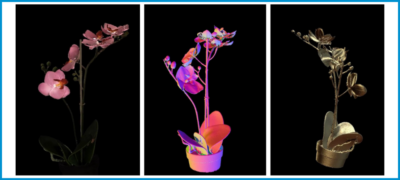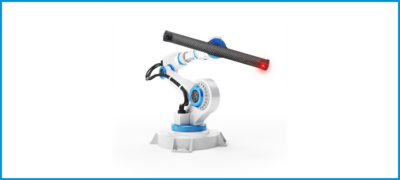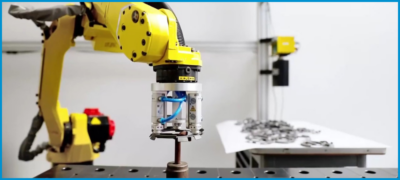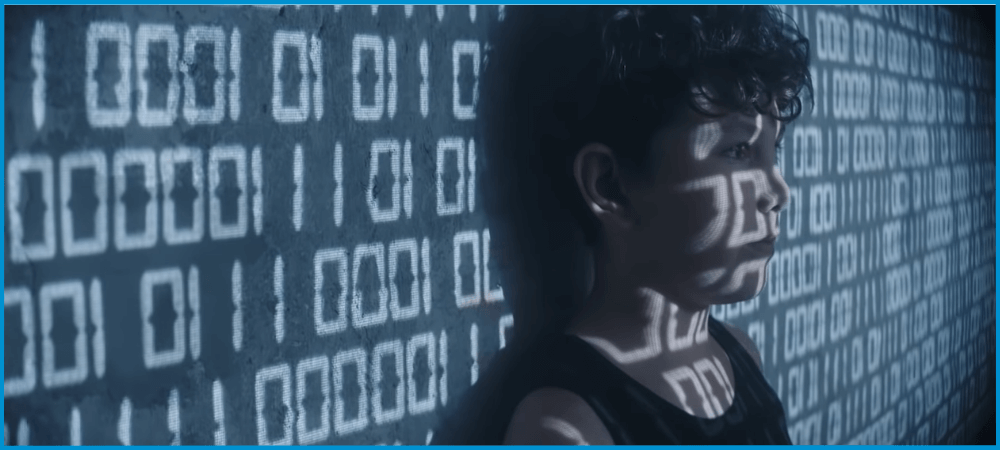
Welcome to the future of 3D vision
For many years, the main challenge in 3D vision was to develop a robotic “eye” that would be able to capture the real world as it is – in motion.
Conventional 3D sensing technologies have been struggling with this challenge, none of them being able to scan objects that are moving fast and, at the same time, provide 3D image data that would satisfy customer requirements for high resolution and accuracy.
This has changed with the novel Parallel Structured Light technology, which ends the dilemma between quality and speed. We have finally arrived in the future of 3D vision.
Parallel Structured Light explained by Marcel Svec, Product Director of the Sensors Business Unit.
In our previous blog article on “The revolution in machine vision”, we discussed the concept of 3D scanning in motion. We answered the question of why it poses a challenge for standard technologies and how the Parallel Structured Light overcomes this challenge. We dived deep into how the technology works and where it stands in comparison to other approaches.
In this blog article, we will take a more practical stance.
As you know, the Parallel Structured Light technology is implemented in the 3D camera MotionCam-3D. Today we will look at the technology from a device-point-of-view: we will go through the main parts and body characteristics of MotionCam-3D, the different models for different applications, its scanning capabilities and where you can use them, and the unique features that you will not get with other technologies.
For this, we will compare 3D image outputs of the most popular 3D sensing technologies and compare them to the Parallel Structured Light to get an objective understanding of their performance.
What is MotionCam-3D?
Let’s start with a very basic explanation of what MotionCam-3D is:
MotionCam-3D is an industrial area-scan 3D camera – i.e. a robotic “eye” – that can be used for a variety of applications to automate industrial, logistical, and other types of processes. By enabling robots to see, the camera allows them to manipulate objects in 3D space or evaluate their quality during manufacturing.
Basic facts about MotionCam-3D
MotionCam-3D consists of three main parts:
- A projector that emits light onto the scene
- A camera unit that captures the scene
- A processing unit that computes the 3D data and sends it over the ethernet to a PC
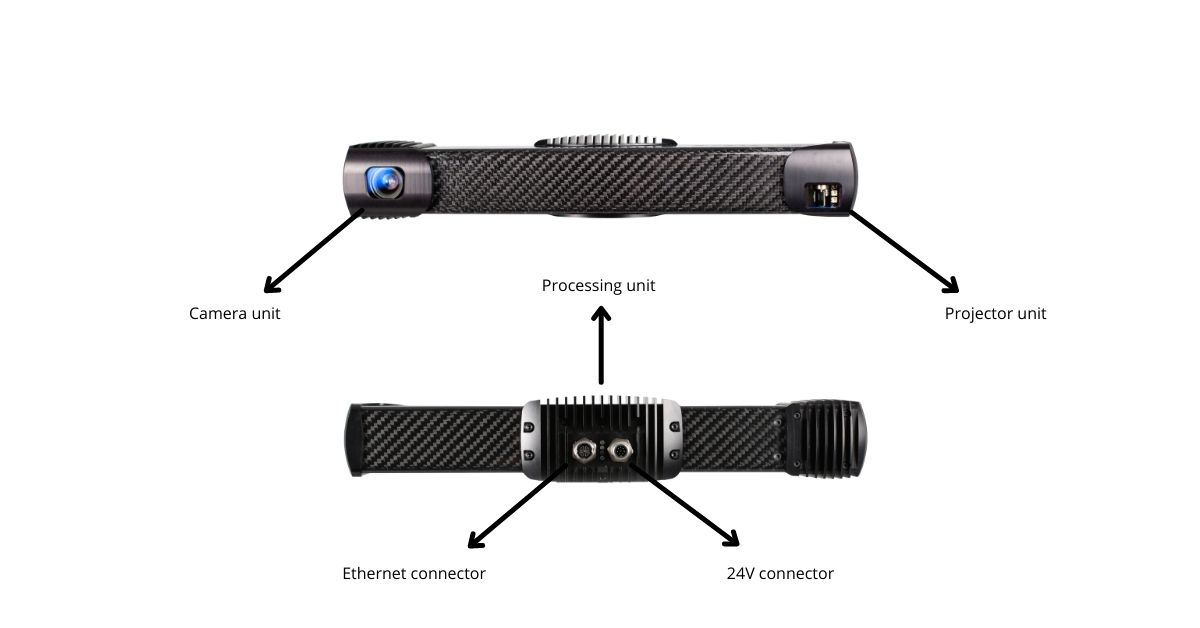
The device can be also powered over the ethernet or, alternatively, over a 24V power connector.
All these components are assembled in a sleek, robust, and durable carbon body, which weighs less than 1.5 kilograms. This is of special advantage for hand-eye applications.
MotionCam-3D is available in three different sizes with different scanning ranges:
- Model S = the smallest model with a scanning range of up to 60 cm. There is also an extended version S+ with a scanning range of up to 150 cm.
- Model M = the medium model with a scanning range of up to 100 cm. The extended version M+ provides a scanning range of up to 150 cm and enhanced accuracy.
- Model L = the largest model with a scanning range of up to 300 cm.
The +models with extended scanning ranges are especially suitable for hand-eye applications.
All five models provide the same resolution of up to 2 million 3D points, whereby the density of the point cloud depends on the scanning distance. For instance, for a scanning distance of 1 meter, the density equals 4 points per 1 millimeter squared.
Where can you use MotionCam-3D?
The robust scanning performance of MotionCam-3D enables you to scan a wide variety of objects made of different types of materials, including but not limited to the following:
- Black rubber
- Aluminum
- Small, thin, and shiny metallic parts
- Plastic objects
- Cardboard
- Semi-transparent or backlight-illuminated objects
The ability to scan various kinds of materials, together with its high resolution, accuracy, and high robustness in demanding industrial settings and challenging conditions, make MotionCam-3D a perfect 3D vision device that can serve automation in a wide range of applications such as:
- Bin picking
- Palletization and depaletization
- Packaging
- Sorting
- Box dimensioning
- Quality inspection
- And many others
Now, what makes MotionCam-3D so unique compared to other 3D sensing technologies?
Parallel Structured Light vs. structured light
If your objective is a high quality of 3D data, structured light sensors may be a good choice for you. They can provide robust data at high accuracy and they can scan all kinds of materials and surfaces in various conditions.
However, they have one serious limitation, which is that they can only be used if the scene is perfectly static. This has the following reason:
A structured light system projects a sequence of light patterns onto the scene. If the object moves, the projected pattern gets broken. This results in an unreadable pattern with high noise, flying artifacts, or incomplete point clouds.
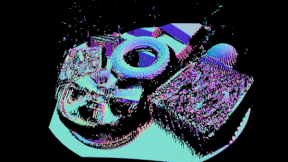
If you need to scan moving scenes, there are other, more suitable technologies. Let’s look at those now.
Parallel Structured Light vs. active stereo / ToF
The most popular 3D sensing technologies for scanning objects in motion are Time-of-Flight (ToF) or active stereo systems.
Their main advantage is high scanning speed. Unfortunately, this is at the cost of quality. The resolution of these systems is usually VGA (Video Graphics Array = a resolution standard for displaying graphics on monitors) and their accuracy can only achieve several millimeters. Another weak point is that they cannot display nice details on the edges of the scanned objects and the 3D image has rather high noise.
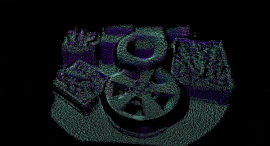
When we summarize the above arguments, we get the following:
On the one hand, there are active stereo or Time-of-Flight systems, which can provide high speed but low quality.
On the other hand, there are structured light systems, which can provide high quality but they cannot be used for scanning moving or vibrating objects.
But we want to achieve both high speed and high quality to be able to scan fast-moving objects in high resolution and accuracy. This is a necessity in countless applications so how can we achieve satisfactory results?
Luckily, the Parallel Structured Light technology brings together the best of both worlds – the speed of active stereo and Time-of-Flight systems and the quality of structured light sensors.
Take a look at the scene below, which was captured by MotionCam-3D.
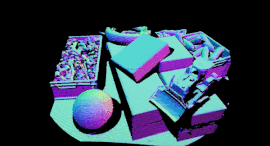
The scene is moving but the 3D image is still perfectly clear. You can see:
- A high resolution point cloud with 900 000 3D points
- Submillimeter accuracy
- Low noise
- Detailed contours of the scanned objects
- High robustness
- Completeness of the scan on various materials
MotionCam-3D has also a static mode, which doubles the accuracy and resolution to 2 Mpx. This makes it a truly versatile device for all kinds of applications.
Paradigm shift that transforms machine vision
The Parallel Structured Light technology finally ends the dilemma about whether you should prefer speed over quality or the other way round for your projects.
It represents a true paradigm shift in the machine vision industry as it can make existing applications faster and more reliable. At the same time, it opens the door to many new applications that were not possible to do before.
The main benefits of MotionCam-3D include:
- It can be deployed in dynamic systems without the need for synchronization
- It can be deployed in applications where the motion is not linear but random
- It can speed up conventional 3D applications such as bin picking
- It can be used for the scanning of vibrating scenes
- It benefits hand-eye robotics as the robot does not need to stop to take a scan
- It provides a continuous stream of high-quality 3D data as compared to technologies that can make only one scan at a time
- Thanks to its high scanning speed, it can replace complicated 2D applications without the need for illumination and on-site calibration
- And much more as this is just a small piece of the possibilities MotionCam-3D offers.
Let’s explore them together. It is time to see the world in motion.


